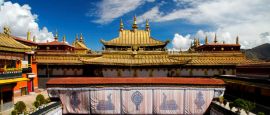Tibet Shopping and nightlife
Shopping in Tibet
Tibet offers some unusual souvenirs. Essential pilgrim supplies such as prayer flags, hand-held prayer wheels and brass butter lamps are available at most monasteries and pilgrimage sites and make for quintessential souvenirs. Handicrafts include hand-painted thangkas (religious paintings) and cast metal statues of Buddhas and protector gods. Hand-woven carpets are making a comeback in Lhasa and Shigatse. Clothes like sheepskin-lined chuba (cloaks) and Tibetan-style cowboy hats, worn by nomads, are a good buy as are the stylish dresses worn by Tibetan women. Take care when shopping for turquoise jewellery, as much of it is fake. Lhasa has easily the best shopping selection, especially at the Barkhor Circuit and Lhasa Village Handicrafts, though you should definitely haggle at the former. Chinese-made trekking gear (some fake, some genuine) can be another good buy, with the selection now rivalling Kathmandu. Note that antiques made before 1949 need a certificate before they can be taken out of the country. Don't buy skins or furs made from endangered animals such as leopard.
Nightlife in Tibet
Lhasa is the only Tibetan town that can claim any real nightlife. Most bars cater to Chinese karaoke but a few offer live blues and pop music. Several restaurants and cafes near the old town offer cheap backpacker hangouts where you can swap travellers tales until the wee hours. Most interesting are the nangma clubs, which feature a uniquely Tibetan mix of karaoke, live music and line dancing. Traditional music and dance is generally limited to festivals, though a couple of places in Lhasa offer staged floor shows aimed at tourists.




 You know where
You know where